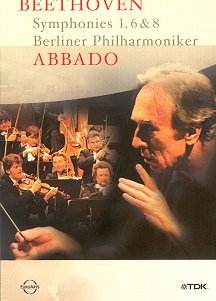This is another in the series of live recordings of
Beethoven Symphonies from Santa Cecilia in Rome played by the Berlin
Philharmonic, under their then Music Director, Claudio Abbado. This
time we have symphonies 1, 6 and 8. This combination runs for the same
time as the companion disc
of Nos. 2 and 5. Abbado and his orchestra performed all nine of
the symphonies in Rome to great critical acclaim. Judging by these DVDs
the concerts must have been well worth attending. These discs may have
a good take up in Italy as reminders of good concerts but I believe
that their appeal should be much wider than this.
The editions of the scores are those from Jonathan
Del Mar who over the past few years has been annotating the music from
original manuscripts, reflecting corrections from Beethoven himself,
and referring to other editions. I am sure that these will be of tremendous
interest to music students and the like, but I am not so sure that the
general music lover will notice that much difference. When changes of
this kind are lauded it is generally for what they inspire in performers
rather for the printed notes.
What has happened here, is that Claudio Abbado has
completely rethought his attitude to Beethovenís symphonies. In the
lighter works, e.g. 1, 2, 4 and 8 all these use much smaller forces
than the others. For example the Berlin Philharmonic is down to three
basses and four cellos with an equivalent reduction in the other string
areas. This results in a much sparer sound than we are accustomed to
and allows Abbado to significantly lighten the textures.
These performances are very similar to those issued
by DG recently on CD. Gone are the lush textures of yesteryear. Abbado,
however supplies something which is more contemporary, and in addition
is able to get the Berlin Philharmonic playing as if their very lives
depend upon it. There is no heavy-handed leadership to do this as the
orchestra gives the impression of working closely with their Music Director
through co-operation, rather than direction.
Abbado, now has a wonderful rapport with his orchestra,
is clearly thoroughly enjoying himself, in spite of looking distinctly
unwell as a result of his recent serious illness. The orchestra is also
clearly enjoying itself with "edge of the seat" playing, and
complete commitment to their conductor.
The First Symphony is played in a very lively fashion,
looking back to Haydn rather than forward to later Beethoven. It is
placed after the Pastoral and before the Eighth, which I find a bit
strange. Still there is nothing to complain about in the performance.
The Pastoral is played in a very light manner, given
that the orchestra is now slightly closer to full strength (here only
four double basses instead of the previous three). The recording quality
is extremely fine, capturing the tonal splendour of this very great
orchestra to perfection. The zooming in on individual instruments in
characteristic BBC fashion enhances the listening experience considerably.
The Eighth is a revelation. Played in this lightweight
manner, the symphony really does sound like Beethovenís "Little
Symphony" as he called it, but still has power reflected in the
playing of the invigorated Berlin Orchestra.
With this DVD, there is also a "Special Feature".
If you push your "Angle" button, you can see the entire work
while watching Abbado, with no other views in the frame. This feature
would have made Karajanís day. Switching back, you get these conductor
shots, mixed in with views of the other members of the orchestra. This
is fascinating if you want to watch the conductor at work.
Donít hesitate with this issue Ė it is a gem.
John Phillips
